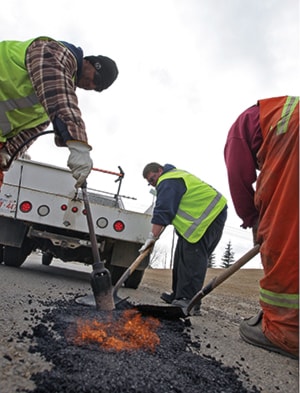Red Deer roadways are already showing signs of that annual, pock-marked spring plague: potholes.
The city’s Public Works Department says it’s planning a possible pothole fixing blitz for as early as next week, weather depending.
“It’s never too early to fix a pothole,” Public Works manager Greg Sikora said. “We’re starting to see them pop open on these freeze-thaw days; several on 40th Avenue and on Gaetz Avenue. It’s not a surprise. We should always see more on high-impact roads.”
Touch up work, such as crack sealing and spray patching, started a few weeks ago in high-traffic zones to tackle the craters that serve up regular headaches to drivers and their vehicles.
Sealing largely involves shovelling a ready-mix asphalt mixture from a truck into the hole and packing it down. But there are many other methods, including chip sealing, sand slurries (bitumen coated with sand brushed into the pothole) and “asphalt rejuvenators.”
From monitoring a pilot project over recent years, Sikora said they have discovered the rejuvenators have a very short service life, lasting about two years.
They’re best used in smaller areas and not in locations such as four-lane highways, he noted.
“There’s new product coming out every year so you have to keep your thumb on it and use ones that are cost effective and operationally effective.”
Last year Public Works also purchased a new piece of equipment, commonly coined a hot box reclaimer, which heats and dispenses hot asphalt for road repairs. The hot box can also be used to recycle old asphalt chunks.
“It makes a better quality patch repair,” Sikora said.
“It seals better to the surrounding edge of asphalt because it’s hot. It’s also designed with a trailer assembly so instead of shovelling off of a flat bed truck, crews shovel out of a hopper on a lower deck so it’s better for ergonomics. ... The operational efficiency has gone up because of it; we’re able to get more repairs done.”
Public Works crews have been instructed to compile lists of potholes throughout their daily operations, such as during plow jobs.
“A couple staff have gone out to strategically look at the high-traffic areas, logging where the potholes are so we get on them prior to complaints.
“We’re looking at measures to deploy hotbox equipment or contracted services to come in to fix the potholes next week while we continue with our snow and ice removal operations.”
Driving the pothole repair program is additional money, about $260,000, for preventive road maintenance, Sikora said.
Potholes are created when water seeps into the cracks in the asphalt, many of which are formed over time along construction joints, and saturates the gravel/sand base.
The saturation causes the base to lose its structural strength, creating a dip and collecting more water until the base is so weak that when a tire travels over it, the asphalt caves in.
“If you can seal up the cracked surface and get water to run off to a curb, you have less potential for potholes to form,” Sikora said.
The city’s method of routing and sealing tries to stop potholes in their tracks and consists of filling large asphalt cracks with a “rubber, polymer, hydrocarbon” sealant that will prevent water from seeping in, Sikora said.
The large amount of snow Central Alberta has witnessed this winter isn’t helping abate the escalating pothole problem, which Sikora equates to a seasonal case of the roadway measles.
“Anytime we have snow sitting on the road in the form of a windrow or drainage obstruction, there is always the increased potential for infiltration,” he said.
However, the real determining factor in just how bad the potholes will be by the time spring dawns depends largely on the number of freeze-thaw cycles.
“With freeze-thaw cycles, the water in the cracks expands when it freezes. More water gathers when it thaws and there’s this expanding and contracting of the cracks, breaking away more asphalt each time.”
Last year, the city repaired well over 10,000 potholes and about 13,000 to 14,000 in 2012, Sikora said.
rfrancoeur@www.reddeeradvocate.com
